Soccer Rules
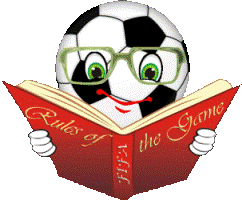
Association football, commonly known as football or soccer, is a sport played between two teams of eleven players with a spherical ball. The Fédération Internationale de Football Association is the international governing body of association football.
The laws that govern football, known officially as the Laws of the Game
Awards
Every year FIFA awards the title of FIFA World Player of the Year to the top men's and women's players of the year.
Content



- Matches can be played on natural or artificial surfaces;
- The color of the playing field must be green;
- The field of play must be rectangular and marked with lines. These lines belong to the areas of which they are boundaries.
- The two longer boundary lines are called touch lines. The two shorter lines are called goal lines.
- The field of play is divided into two halves by a halfway line, which joins the midpoints of the two touch lines.
- The centre mark is indicated at the midpoint of the halfway line. A circle with a radius of 9.15 m (10 yds) is marked around it.
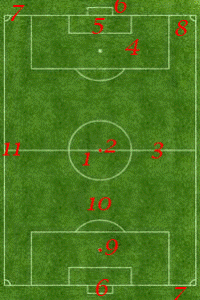
- Circle center
- Center mark
- Halfway line
- Penalty box
- Goal box
- Goal
- Endline (aka Goalline)
- Corner arc
- Penalty kick mark
- Penalty box ark
- Sideline (aka Touchline)
- Marks may be made off the field of play, 9.15 m (10 yds) from the corner arc and at right angles to the goal lines and the touch lines, to ensure that defending players retreat this distance when a corner kick is being taken.
Regular matches:
lenght (touch line) - min: 90m / max: 120m;
width (goal line) - min: 45m / max: 90m;
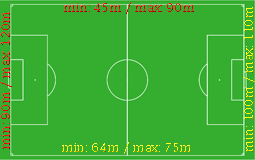
International matches:
lenght (touch line) - min: 100m / max: 110m;
width (goal line) - min: 64m / max: 75m;
- The area between two lines, drawn at right angles to the goal line, 16.5 m (18 yds) from the inside of each goalpost and joined by a line drawn parallel with the goal line.
- Within each penalty area, a penalty mark is made 11 m (12 yds) from the midpoint between the goalposts and equidistant to them.
- An arc of a circle with a radius of 9.15 m (10 yds) from the centre of each penalty mark is drawn outside the penalty area.
- A goal must be placed on the centre of each goal line.
- A goal consists of two upright posts equidistant from the corner flagposts and joined at the top by a horizontal crossbar. The goalposts and crossbar must be made of wood, metal or other approved material. They must be square, rectangular, round or elliptical in shape and must not be dangerous to players.
- The distance between the posts is 7.32 m (8 yds) and the distance from the lower edge of the crossbar to the ground is 2.44 m (8 ft).



Qualities and measurements:
The ball is:
- Spherical;
- Made of leather or other suitable material;
- Of a circumference of not more than 70 cm and not less than 68 cm;
- Of a pressure equal to 0.6 - 1.1 atmosphere at sea level;

Replacement of a defective ball:
If the ball bursts or becomes defective during the course of a match:
If the ball bursts or becomes defective during a penalty kick or during kicks from the penalty mark as it moves forward and before it touches any player or the crossbar or goalposts:
If the ball bursts or becomes defective whilst not in play at a kick-off, goal kick, corner kick, free kick, penalty kick or throw-in:
The ball may not be changed during the match without the authority of the referee.
- The match is stopped
- The match is restarted by dropping the replacement ball at the place where the original ball became defective, unless play was stopped inside the goal area, in which case the referee drops the replacement ball on the goal area line parallel to the goal line at the point nearest to where the original ball was located when play was stopped.
- the penalty kick is retaken
- the match is restarted accordingly



Numbers of Players:
A match is played by two teams, each consisting of not more than eleven players, one of whom is the goalkeeper.
A match may not start if either team consists of fewer than seven players.
Numbers of Substitutions:
Official competitions:
Other matches:
- In any match, played in an official competition organised under the auspices of FIFA, may be used up to a maximum of three substitutes;
- The rules of the competition must state how many substitutes may be nominated, from three up to a maximum of seven.
- Up to a maximum of six substitutes may be used in national "A" team matches;
- In all other matches, a greater number of substitutes may be used provided that:
- the teams concerned reach agreement on a maximum number;
- the referee is informed before the match;
- no more than six substitutes are allowed, If the referee is not informed, or if no agreement is reached before the match.
- the referee is informed before the match;
- no more than six substitutes are allowed, If the referee is not informed, or if no agreement is reached before the match.
Substitution procedure:
the names of the substitutes must be given to the referee prior to the start of the match;
Any substitute whose name is not given to the referee at this time may not take part in the match;
Changing the goalkeeper:
Any of the other players may change places with the goalkeeper, provided that:
- the referee is informed before the change is made;
- the change is made during a stoppage in the match;
- the referee is informed before the match



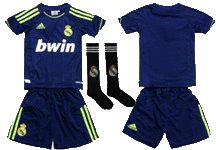
Safety:
A player must not use equipment or wear anything that is dangerous to himself or another player.
Basic equipment:
The basic compulsory equipment of a player comprises the following separate items:
- a jersey or shirt with sleeves - players must wear the same colored jersey or shirts;
- shorts;
- stockings;
- shinguards - All youth programs require shin guards to be worn by all players;
- footwear;



The authority of the referee:
Each match is controlled by a referee who has full authority to enforce the Laws of the Game in connection with the match to which he has been appointed.
There is one difference between soccer and most other sports played in America. In soccer, the referee may let play continue and not call a foul if he or she thinks that stopping play would give an advantage to the team committing the foul. This is called the “advantage clause”. The referee should say “play on” when this occurs.




- when the whole of the ball leaves the field of play;
- which team is entitled to a corner kick, goal kick or throw-in;
- when a player may be penalised for being in an offside position;
- when a substitution is requested;
- when misconduct or any other incident occurs out of the view of the referee;
- when offences have been committed whenever the assistant referees have a better view than the referee;
- whether, at penalty kicks, the goalkeeper moves off the goal line before the ball is kicked and if the ball crosses the line.



Periods of play:
The match lasts two equal periods of 45 minutes, unless otherwise mutually agreed between the referee and the two teams.
The duration of the game will depend on the age of the children. Older children will more than likely have two halves. Younger children often times play four quarters.
Half-time interval:
Players are entitled to an interval at half-time;
The half-time interval must not exceed 15 minutes.
Penalty kick:
If a penalty kick has to be taken or retaken, the duration of either half is extended until the penalty kick is completed.
Abandoned match:
An abandoned match is replayed unless the competition rules provide otherwise.



Definition of kick-off - A kick-off is a way of starting or restarting play after a goal has been scored or to start the second half or a new quarter.
Procedure:Before a kick-off at the start of the match or extra time:
Kick-off:
A dropped ball is a method of restarting play when, If, while the ball is still in play. The referee is required to stop play emporarily for any reason not mentioned elsewhere in the Laws of the Game, the match is restarted with a dropped ball.
The referee restarts play by dropping the ball between two players, one from each team. A dropped ball may not be played until it touches the ground. The first player playing the ball is allowed to play the ball again without it having to be touched by another player.
Procedure:
- a coin is tossed and the team that wins the toss decides which goal it will attack in the first half of the match.
- the other team takes the kick-off to start the match.
- the team that wins the toss takes the kick-off to start the second half of the match.
- in the second half of the match, the teams change ends and attack the opposite goals.
- after a team scores a goal, the kick-off is taken by the other team;
- all players must be in their own half of the field of play;
- the opponents of the team taking the kick-off are at least 9.15 m (10 yds) from the ball until it is in play;
- the ball must be stationary on the centre mark;
- the referee gives a signal;
- the ball is in play when it is kicked and moves forward;
- the kicker must not touch the ball again until it has touched another player.



Ball out of play
The ball is out of play when:
The ball is in play at all other times, including when:
- it has wholly touch line whether on the ground or crossed the goal lineor in the air
- play has been stopped by the referee
- it rebounds off a goalpost, crossbar or corner flagpost and remains in the field of play
- it rebounds off either the referee or an assistant referee when they are on the field of play



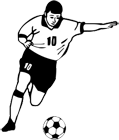



Offside position
A player is in an offside position if he is nearer to his opponents' goal line than both the ball and the second-last opponent
A player is not in an offside position if:
- he is in his own half of the field of play
- he is level with the second-last opponent
- he is level with the last two opponents
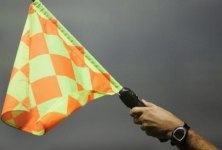
Offence - A player in an offside position is only penalised if, at the moment the ball touches or is played by one of his team, he is, in the opinion of the referee, involved in active play by:
interfering with play
interfering with an opponent
gaining an advantage by being in that position
No offence - There is no offside offence if a player receives the ball directly from a goal kick, a throw-in or a corner kick.



Direct free kick - A direct free kick is awarded to the opposing team if a player:
kicks or attempts to kick an opponent;
trips or attempts to trip an opponent;
jumps at an opponent;
jumps at an opponent;
jumps at an opponent;
charges an opponent;
strikes or attempts to strike an opponent;
jumps at an opponent;
charges an opponent;
strikes or attempts to strike an opponent;
pushes an opponent;
tackles an opponent;
holds an opponent;
spits at an opponent;
handles the ball deliberately;
An indirect free kick is awarded to the opposing team if a goalkeeper, inside his own penalty area:
An indirect free kick is also awarded to the opposing team if, in the opinion of the referee, a player:
A direct free kick is taken from the place where the offence occurred.
Penalty kick - A penalty kick is awarded if any of the above ten offences is committed by a player inside his own penalty area, irrespective of the position of the ball, provided it is in play. Indirect free kick:
Penalty kick - A penalty kick is awarded if any of the above ten offences is committed by a player inside his own penalty area, irrespective of the position of the ball, provided it is in play. Indirect free kick:
- controls the ball with his hands for more than six seconds before releasing it from his possession
- touches the ball again with his hands after he has released it from his possession and before it has touched another player
- touches the ball with his hands after it has been deliberately kicked to him by a team-mate
- touches the ball with his hands after he has received it directly from a throw-in taken by a team-mate
- plays in a dangerous manner
- impedes the progress of an opponent
- prevents the goalkeeper from releasing the ball from his hands
- commits any other offence, not previously mentioned in Law 12, for which play is stopped to caution or send off a player
Misconduct - There are two kinds of misconduct:
When an action results in a player being ejected from the game, a “red card”. The referee has the authority to “red card” coaches or spectators because of misconduct or interference of the game.



The direct free kick: - Ball enters the goal:
if a direct free kick is kicked directly into the opponents’ goal, a goal is awarded
if a direct free kick is kicked directly into the team’s own goal, a corner kick is awarded to the opposing team
if a direct free kick is kicked directly into the opponents’ goal, a goal is awarded
Indirect free kick:
Signal - The referee indicates an indirect free kick by raising his arm above his head. He maintains his arm in that position until the kick has been taken and the ball has touched another player or goes out of play.
Ball enters the goal:
if an indirect free kick is kicked directly into the opponents' goal, a goal kick is awarded
if an indirect free kick is kicked directly into the team's own goal, a corner kick is awarded to the opposing team
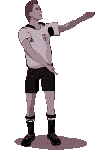
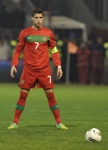
- all opponents must be at least 9.15 m (10 yds) from the ball
- all opponents must remain outside the penalty area until the ball is in play
- the ball is in play when it is kicked directly out of the penalty area
- a free kick awarded in the goal area may be taken from any point inside that area
- all opponents must be at least 9.15 m (10 yds) from the ball until it is in play, unless they are on their own goal line between the goalposts
- the ball is in play when it is kicked and moves an indirect free kick awarded inside the goal area must be taken on the goal area line parallel to the goal line at the point nearest to where the infringement occurred
- all opponents must be at least 9.15 m (10 yds) from the ball until it is in play
- the ball is in play when it is kicked and moves
- the free kick is taken from the place where the infringement occurred or from the position of the ball when the infringement occurred



A penalty kick is awarded against a team that commits one of the ten offences for which a direct free kick is awarded, inside its own penalty area and while the ball is in play. A goal may be scored directly from a penalty kick. Additional time is allowed for a penalty kick to be taken at the end of each half or at the end of periods of extra time.
Position of the ball and the players:
- inside the field of play
- outside the penalty area
- behind the penalty mark
- at least 9.15 m (10 yds) from the penalty mark



A throw-in is:
a method of restarting play;
awarded to the opponents of the player who last touched the ball when the whole of the ball crosses the touch line, either on the ground or in the air;
A goal cannot be scored directly from a throw-in.
Procedure:
At the moment of delivering the ball, the thrower faces the field of play. He has part of each foot either on the touch line or on the ground outside the touch line and holds the ball with both hands. The delivering of the ball is from behind and over the player head and it's from the point where it left the field of play.
All opponents must stand no less than 2 m (2 yds) from the point at which the throw-in is taken.
The ball is in play when it enters the field of play.
After delivering the ball, the thrower must not touch the ball again until it has touched another player.




A goal kick is:
a method of restarting play;
awarded when the whole of the ball passes over the goal line, either on the ground or in the air, having last touched a player of the attacking team, and a goal is not scored in accordance with Law 10;
A goal may be scored directly from a goal kick, but only against the opposing team.
Procedure
The ball is kicked from any point within the goal area by a player of the defending team;
Opponents remain outside the penalty area until the ball is in play;
The kicker must not play the ball again until it has touched another player;
The ball is in play when it is kicked directly out of the penalty area;



A corner kick is:
a method of restarting play;
awarded when the whole of the ball passes over the goal line, either on the ground or in the air, having last touched a player of the defending team, and a goal is not scored in accordance with Law 10;
A goal may be scored directly from a corner kick, but only against the opposing team
Procedure:
The ball must be placed inside the corner arc nearest to the point where the ball crossed the goal line;
The corner flagpost must not be moved;
Opponents must remain at least 9.15 m (10 yds) from the corner arc until the ball is in play;
The ball must be kicked by a player of the attacking team;
The ball is in play when it is kicked and moves;
The kicker must not play the ball again until it has touched another player.





